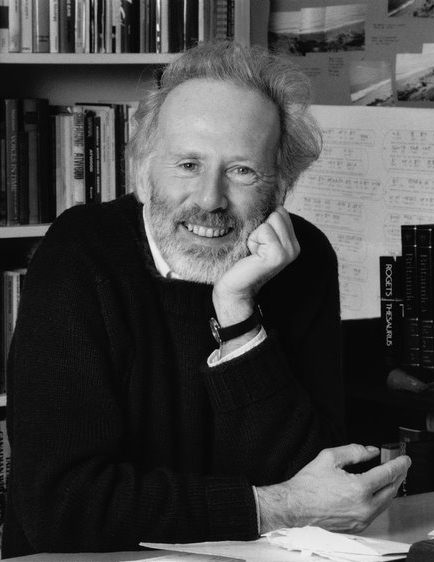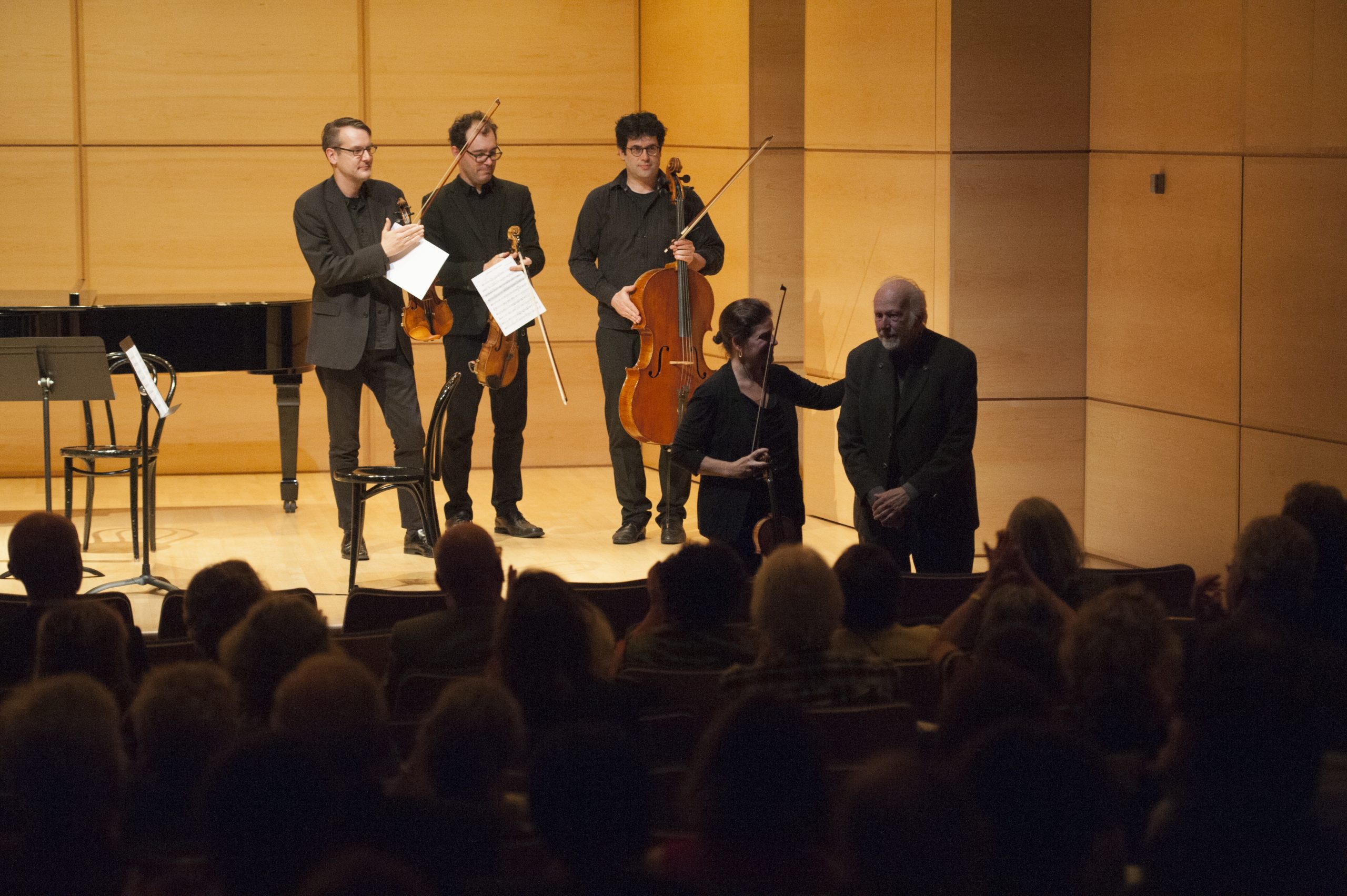The Molinari Quartet with R. Murray Schafer after a performance of his quartet “Alzheimer’s Masterpiece”. Photo credit: Magalie Dagenais/2016
We asked a number of people from the five regions of the Canadian Music Centre to offer their thoughts and reflections about the influence of R. Murray Schafer. Known affectionately to people close to him as Our Murry Schafer, Murray had an impact on the CMC, its staff and boards over the decades and all the communities it serves throughout his career.
In his student days he worked in the CMC library. During my student days at the Faculty of Music at U of T, I joined the many thousands of people that made the early morning voyage in the dark to Heart Lake just north of Toronto for the premier of his opera Princess of the Stars presented by New Music Concerts. Little did I know that I was witnessing the Prologue to his massive undertaking Patria that would be one of the greatest compositions by a Canadian composer resulting in 12 works taking him 40 years to complete. The Princess of the Stars begins one hour before dawn and features canoeists paddling the artists around in the lake in an elaborate canoe ballet. Being an avid canoeist, I was quite interested in this novel approach and in fact several of my friends were amongst the paddlers.
Later in my career when I was Executive Director of Ottawa Chamberfest, we presented the St. Lawrence String Quartet, a champion of his works. They performed Murray’s third String Quartet which was as shocking as it was fantastic. Murray was in attendance and the day before he took patrons on a walking tour of the city where he instructed them on listening to the sounds that were so inspiring and intriguing to him and which formed the basis of so much of his work.
When I became the Executive Director of the CMC in 2014, I had the privilege of getting to know him and his partner Eleanor. We met on a number of occasions, and I had the absolute pleasure of visiting them at their beloved farm just east of Toronto. These visits allowed me to see the operations of Arcana Publishing, devoted exclusively to Murray’s works. and to feel the spirit and beauty of that environment.
A highlight of my time at the CMC was the 2015 performance of Apocalypsis presented by Luminato at the Sony Centre in Toronto. 1,000 performers were involved. It was simply spectacular. Murray was there and received a huge ovation as he went to the stage at the end. I consider myself fortunate having been there because it was just the second performance of the work and the likelihood of a remount is slim. After the performances were completed, I was thrilled when Caroline Hollway, Production Manager for Luminato called me to ask if we would like to have all of their production files in our Archives. I immediately responded yes. So, if there is someone looking to do a remount these files will be a useful resource.
It has been my great privilege to have known Murray. My deepest condolences go out to Eleanor.
Glenn Hodgins, President & CEO, CMC Canada

From left to right: composer R. Murray Schafer, his wife Eleanor and Olga Ranzenhofer of the Molinari Quartet.
In 1981 when I arrived at the CMC, plenty well-intentioned ‘advisers’ offered me guidance on dealing with Associate Composers. For Murray Schafer, the original advice was generally he’s difficult!
All that original counselling was useful, except for one notable exception – Murray Schafer, whom I found to be co-operative, unassumingly shy, appreciative of my struggles with the Music Centre’s goals, and supportive of whatever I asked of him. The same qualities were true for forty subsequent years through all my other roles and projects. What moments do I particularly recall?
1983, RA, from the Patria cycle, at the Ontario Science Centre, where Murray had us attendees staying overnight as part of the pageantry, eventually to be awakened by Maureen Forrester chanting the Amente-Nufe aria, along with John Wyre, I believe, on percussion…15 minutes of the most moving sounds I’ve ever encountered.
1985, and the opening ceremonies of Chalmers House where five brass musicians arrived from different parts of downtown Toronto, individually playing Murray’s situational music, culminating in an ensemble fanfare, finally to celebrate a national home for CMC Associates.
1987, when the first Glenn Gould Prize was awarded…and to a Canadian, no less. Three years later, Sir Yehudi Menuhin told me privately that there had been some pushback to any Canadian being the first laureate, so he, as Chair of that international jury, spoke up strongly about how Murray was a worthy honoree of international renown and how Canadians ought not to be reluctant in acclaiming one of their own. Right on!
1989, when former CMC President Stanley Witkin wanted a unique gift to celebrate his wife’s birthday and I suggested speaking with his boyhood friend; Murray accepted Stan’s commission for a fifth string quartet and named it The Rosalind.
2001 – 2018, at Stratford Summer Music where Murray conducted Music for Wilderness Lake three times along the Avon River, where we celebrated his 80th birthday with a great concert by his musical friends, and where often his choral works were sung by the Vancouver Chamber Choir, even by local amateur choristers who admitted that accomplishing those artistic Schafer scores became highlights of their lives in music.
Of one thing I’m very sure. Murray’s creativity will flourish long after all of us bid this planet farewell. In fact, I believe the future holds more promise for Murray’s music than at any point of his own 88 years. Now, where’s the dynamic young producer who’ll dare to give the world the complete PATRIA cycle?
John A. Miller, CMC Executive Director, 1981-1986
• • • • •

Emily Doolittle, R. Murray Schafer, canoe at the Music For Wilderness Lake event, Scotia Festival (Camp Kidston) 1993
I absolutely would not be who I am without R Murray Schafer, and I think the same is true for many Canadian musicians. My own history with Schafer began with hearing his Third String Quartet at Scotia Festival in 1989: I knew right then that I needed to become a musician, and I’ve spoken with others who found that performance similarly transformative. At around the same time, we sang Epitaph for Moonlight in the Halifax High Schools Choir. We were entranced by the musical and visual beauty of Schafer’s graphic scores: but even more by realizing that here was a composer who valued music made by children just as much as music made by professionals. This empowered us to take our own music making more seriously. I attended Schafer’s overnight Music for Wilderness Lake event at Camp Kidston in 1993 and experienced, along with hundreds of other intrepid Nova Scotians, the magic of music created in collaboration with the dusk and dawn, the lakes and skies, the wild animals and the human community. But for me my profoundest connection with Schafer was the 11 years I was part of his collaborative, week-long music-ritual-drama And Wolf Shall Inherit the Moon, which (still) takes place each summer in the Ontarian wilderness, with participants attending from across Canada, Europe, and South America. I learned so much at Wolf about the incredible power of creating art for and with a particular environment, and for and with a community where everyone’s contributions are valued equally. The Wolf Project was not perfect: in particular, there were issues of problematic cultural appropriation which came to trouble many, though in recent years Schafer and the participants worked hard to put these right. Indeed, perhaps the most powerful lesson I learned at Wolf is that art doesn’t have to be perfect to be incredible: what matters is listening, caring for the community, working through the difficult bits, and always staying open to new possibilities. That is where we find real strength and unexpected beauty.
Emily Doolittle, CMC Associate Composer
(on behalf of CMC Atlantic Region)
• • • • •
It is difficult to appreciate the manifold impacts of Murray’s presence and process—he cast himself as a defiant figure, sometimes the trickster, in our shared scenery. He gave the field of sound studies a trove of materials and methodologies to apply, contest, and extend, particularly now as our practices evolve to encompass many of the analytical perspectives overlooked in the earliest days of the World Soundscape Project. It is remarkable to consider that these deliberations on his work will continue here in Canada, and amongst communities of educators, ecologists, acousticians and others throughout the world. Undoubtedly, the Venn diagram of Murray’s conceptual and artistic reach is an intriguing and unique one.
Matthew Fava, Director, CMC Ontario
• • • • •
Le grand compositeur canadien R.Murray Schafer nous a fait l’honneur de venir à Montréal pour la soirée bénéfice du Centre de musique canadienne au Québec qui a eu lieu en 2016. Une œuvre intitulée « Alzheimer’s Masterpiece » fut créée par le Quatuor Molinari à cette occasion, en présence du compositeur.
Sa musique est ces livres illustrés sont d’une grande beauté. La maladie aura eu raison de lui… Une grande perte pour la musique contemporaine canadienne.
Claire Marchand, Director, CMC Québec
• • • • •
I have several great memories of Murray Schafer. He spoke at our office in the late ‘80s in conjunction with his archives being held at U of C. I heard his symphony at Carnegie Hall with the Winnipeg Symphony. I heard the 12 trombones of Wilderness Lake performed in Saskatoon at the riverside and had the chance to hang out with him a bit at the CMC Quebec fundraiser a few years back.
Perhaps my greatest memory, however, was hearing Patria IV: The Black Theatre of Hermes Trismegistos, June 9, 1992, Great Hall, Union Station, Toronto, Ontario; conductor, Michael J. Baker. Because of its daily transit usage, the performance did not begin until midnight. I was smart — I had a nap in the afternoon, and unlike many, I was able to stay awake for the entire spectacular. Painted bodies, elaborate costumes, singers descending from the roof on ropes, marvellous music. Wow! Unforgettable!
John Reid, Director, CMC Prairie

Photo by André Leduc
I will never forget hearing the National Youth Orchestra perform R. Murray Schafer’s North / White at its premiere in Vancouver in 1973. It was a pivotal time in Schafer’s development resulting from his decade here in Vancouver, where he was both transforming and confounding the world of composition by starting The Vancouver Soundscape and World Soundscape Project.
North / White is a bombastic, cacophonic, and totally overwhelming piece of music. It was unlike anything I’d ever heard, featuring massive orchestral forces, a snowmobile, a chainsaw, and wah-wah board — a giant piece of tin flexed rhythmically to evoke the relentless pumping of an oil derrick.
That piece of music roared! Yet it was lyrically eerie and stunningly beautiful. Even before Greenpeace had been founded, Schafer was trying to wake the world up to the exquisitely fragile beauty of Canada’s pristine arctic and the danger it faced from industrialization and oil. If only we had listened.
Sean Bickerton, Director, CMC BC
• • • • •
Learn more about R. Murray Schafer and view his works in the CMC Library or Shop.

